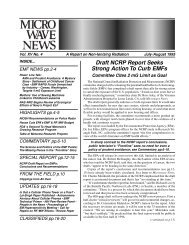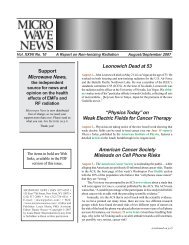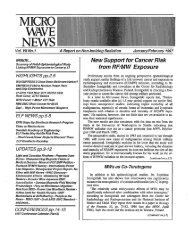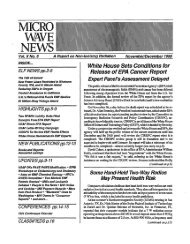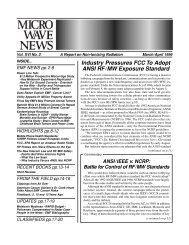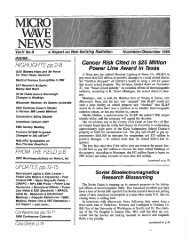Mobile Phones, Cancer Not Linked In Two Short ... - Microwave News
Mobile Phones, Cancer Not Linked In Two Short ... - Microwave News
Mobile Phones, Cancer Not Linked In Two Short ... - Microwave News
You also want an ePaper? Increase the reach of your titles
YUMPU automatically turns print PDFs into web optimized ePapers that Google loves.
Special Report: <strong>Mobile</strong> <strong>Phones</strong> and <strong>Cancer</strong><br />
just shy of a significant association (p=0.06). But when the analysis<br />
was restricted to tumors in the temporal lobe, which is closer<br />
to a phone’s antenna than the frontal lobe, the opposite was true:<br />
Tumors were more likely to occur on the opposite side from the<br />
phone (p=0.33). For this reason, the AHF team did not see the<br />
first finding as evidence of a real effect.<br />
This part of the AHF study drew particular notice when initial<br />
results were announced in 1999 because it paralleled a study<br />
by Dr. Lennart Hardell of the Örebro Medical Center in Sweden<br />
(see MWN, M/J99). Hardell found that when tumors developed<br />
they were more likely to occur near where the phone was usually<br />
held. <strong>In</strong> Hardell’s case, the first report was of a nonsignificant<br />
association—but when adjusted for past exposure to Xrays,<br />
the link became significant (see MWN, M/J00).<br />
Hardell’s analysis was based on both the temporal and occipital<br />
lobes (at the side and rear of the brain), while Muscat’s<br />
analysis was based on the temporal lobe alone. Muscat said that<br />
this choice was made based on discussions with Dr. Om Gandhi<br />
of the University of Utah in Salt Lake City. Hardell told <strong>Microwave</strong><br />
<strong>News</strong> that some exposure would also occur in the occipital<br />
lobe, and that he and coauthor Dr. Kjell Hansson Mild had therefore<br />
decided to include it. He noted that this accounted for only<br />
a few of the tumors in their analysis.<br />
Hardell said that his own results “should be interpreted with<br />
caution, since they are based on small numbers.” He noted that<br />
neither he nor Muscat had found any overall increase. The main<br />
point, he said, is that “the issue of brain tumors and cellular telephones<br />
cannot be put to rest.”<br />
“Neither [the AHF nor the NCI] study showed any evidence<br />
of brain cancer risk, and that’s an important contribution,” Dr.<br />
Nancy Dreyer, of the Epidemiology Division of <strong>In</strong>genix in Newton<br />
Lower Falls, MA, said in an interview. “But the trouble with<br />
studying cell phones is that the technology is changing and publicuse<br />
is growing so rapidly.” Dreyer pointed out that, “The prices<br />
are now so low that people are using them for many more minutes.<br />
But in 1994 the typical call in the U.S. was just two minutes<br />
long.”<br />
Dreyer noted the ascendancy of phones using digital signals.<br />
The NCI team cautions that, “Because of the timing of this study,<br />
we presume that our results pertain primarily to analog telephones<br />
with frequencies of 800 to 900 MHz.” The AHF study asked<br />
participants which type of phone they used; 88% of all phones<br />
inthe study were analog. Today digital phones are becoming dominant<br />
in the U.S., as they have been for some time in Europe.<br />
<strong>In</strong>skip said that the 12-country study being coordinated by<br />
the <strong>In</strong>ternational Agencyfor Research on <strong>Cancer</strong> (IARC) in Lyon,<br />
France, will address some of these limitations (see MWN, J/F98,<br />
S/O98 and M/A00). “The IARC study is not only much larger,<br />
but is being carried out in countries where cellular phone use in<br />
large numbers began earlier than in the U.S., and where the switch<br />
to digital phones came earlier as well,” <strong>In</strong>skip said. “Plus it’s<br />
simply being done later, and all those factors mean that it will<br />
tell us more.” <strong>In</strong>skip argued that the IARC effort showed that<br />
the issue was not being neglected: “The studies that need to be<br />
done, are being done.” The AHF paper also notes the importance<br />
of the IARC effort.<br />
But Dr. Kenneth Rothman, of the Boston University School<br />
Danish Cell Phone Epi Study<br />
Slated for Publication in February<br />
A cohort study of 550,000 mobile phone users in Denmark<br />
is slated for publication in the February 7 issue of the<br />
Journal of the National <strong>Cancer</strong> <strong>In</strong>stitute.<br />
The study was led by Dr. Christoffer Johansen of the<br />
Danish <strong>Cancer</strong> Society (DCS) in Copenhagen, with financial<br />
support from the DCS and two Danish wireless firms,<br />
TeleDanmark Mobil and Sonofon. The companies provided<br />
information on the annual amount of use by each of their<br />
subscribers from 1982 to 1995, and the researchers linked<br />
this to incidence data in Denmark’s national cancer registry.<br />
Johansen and Dr. Jørgen Olsen, also of the DCS, published<br />
a description of the study design in Radiation Protection<br />
Dosimetry (83, pp.155-157, 1999). Johansen is heading<br />
up the Danish portion of the 12-country IARC study on<br />
mobile phones and cancer (see MWN, M/J99 and M/A00).<br />
of Public Health and the editor of Epidemiology, thinks that even<br />
the IARC study will be limited. “These two new studies are both<br />
very good, and they add a lot of information,” Rothman told<br />
<strong>Microwave</strong> <strong>News</strong>. “But the bigger issue with these studies is that<br />
if people are hazy about the extent of their use, it can diminish<br />
the ability to see an effect.” What is needed, argued Rothman, is<br />
a prospective cohort study, following users over time.<br />
<strong>In</strong> a review article in the November 25 issue of the Lancet<br />
(356, pp.1837-1840), Rothman concludes that “it is too soon for<br />
a verdict on the health risks of cellular telephones.”<br />
Rothman and Dreyer worked together on two cohort analyses<br />
of cellular phone users in research funded by the industry<br />
group Wireless Technology Research (WTR). Their study was<br />
cut short by a lawsuit and by the end of WTR funding (see MWN,<br />
M/J96 and N/D97).<br />
The small number of highly exposed subjects in the two justpublished<br />
studies was highlighted by one table in the NCI team’s<br />
paper in NEJM. It examines the relative risks in this study for<br />
various tumor subtypes. But the “phone user” group in this table<br />
is defined as those who had used a mobile phone more than five<br />
times in their lives, and the text of the paper notes that the study<br />
did not have sufficient statistical power to assess the risks of subtypes.<br />
“Clearly we don’t have the power to look at subtype,” <strong>In</strong>skip<br />
conceded in an interview. But he said the table was needed anyway<br />
because of the controversy over neuroepitheliomatous tumors<br />
in the AHF study. “It’s out there in the literature,” <strong>In</strong>skip<br />
explained, “and some people have jumped on that.” <strong>In</strong>skip noted<br />
that this table showed a relative risk of neuroepitheliomatous<br />
tumors among phone users of 0.5 (CI=0.1-2.0)—a decrease in<br />
risk, opposite to the AHF finding. “That’s precisely the kind of<br />
bouncing around that you’d expect if it’s a chance finding,” he<br />
said.<br />
Dr. Anders Ahlbom of the Karolinska <strong>In</strong>stitute in Stockholm<br />
said that in evaluating early epidemiological studies of mobile<br />
phones, “One should not forget that the basis of this research is<br />
not a hypothesis based on experimental or epidemiological data,”<br />
MICROWAVE NEWS January/February 2001 12



